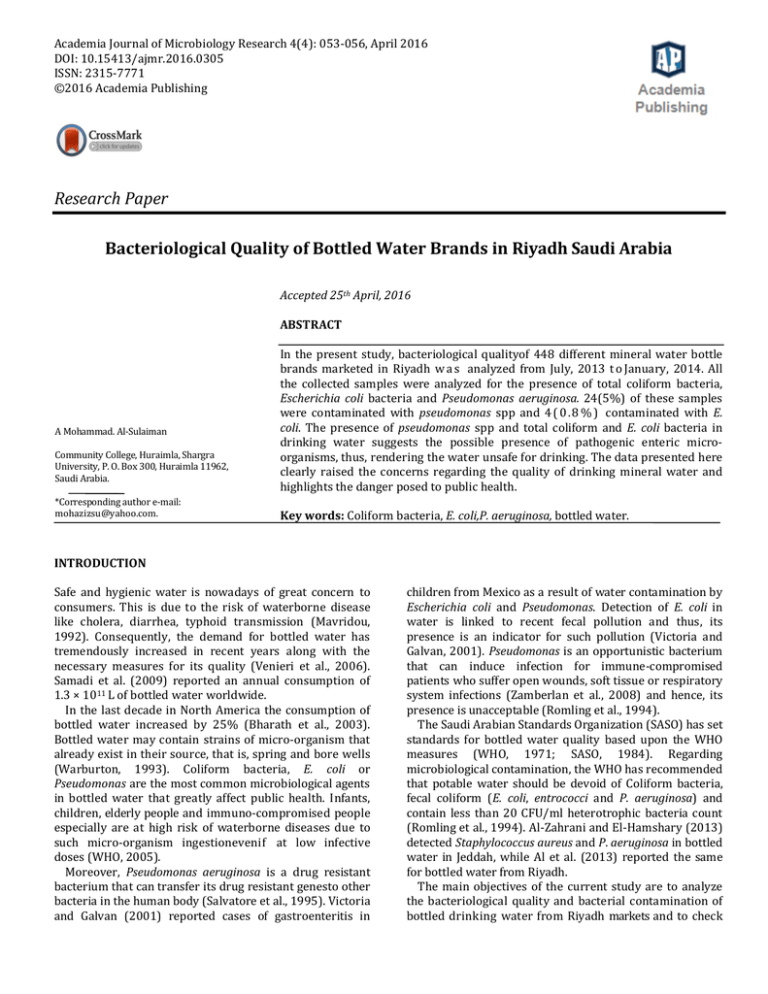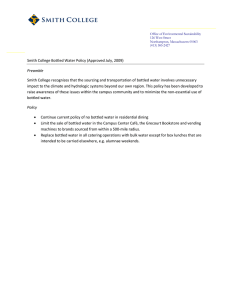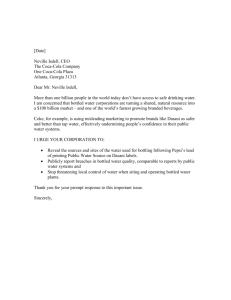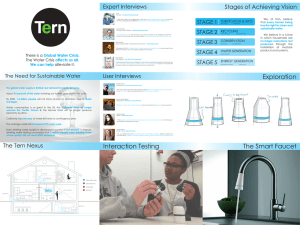Full Text - Academia Publishing
advertisement

Academia Journal of Microbiology Research 4(4): 053-056, April 2016 DOI: 10.15413/ajmr.2016.0305 ISSN: 2315-7771 ©2016 Academia Publishing Research Paper Bacteriological Quality of Bottled Water Brands in Riyadh Saudi Arabia Accepted 25th April, 2016 ABSTRACT A Mohammad. Al-Sulaiman Community College, Huraimla, Shargra University, P. O. Box 300, Huraimla 11962, Saudi Arabia. *Corresponding author e-mail: mohazizsu@yahoo.com. In the present study, bacteriological qualityof 448 different mineral water bottle brands marketed in Riyadh w a s analyzed from July, 2013 t o January, 2014. All the collected samples were analyzed for the presence of total coliform bacteria, Escherichia coli bacteria and Pseudomonas aeruginosa. 24(5%) of these samples were contaminated with pseudomonas spp and 4 ( 0 . 8 % ) contaminated with E. coli. The presence of pseudomonas spp and total coliform and E. coli bacteria in drinking water suggests the possible presence of pathogenic enteric microorganisms, thus, rendering the water unsafe for drinking. The data presented here clearly raised the concerns regarding the quality of drinking mineral water and highlights the danger posed to public health. Key words: Coliform bacteria, E. coli,P. aeruginosa, bottled water. INTRODUCTION Safe and hygienic water is nowadays of great concern to consumers. This is due to the risk of waterborne disease like cholera, diarrhea, typhoid transmission (Mavridou, 1992). Consequently, the demand for bottled water has tremendously increased in recent years along with the necessary measures for its quality (Venieri et al., 2006). Samadi et al. (2009) reported an annual consumption of 1.3 × 1011 L of bottled water worldwide. In the last decade in North America the consumption of bottled water increased by 25% (Bharath et al., 2003). Bottled water may contain strains of micro-organism that already exist in their source, that is, spring and bore wells (Warburton, 1993). Coliform bacteria, E. coli or Pseudomonas are the most common microbiological agents in bottled water that greatly affect public health. Infants, children, elderly people and immuno-compromised people especially are at high risk of waterborne diseases due to such micro-organism ingestionevenif at low infective doses (WHO, 2005). Moreover, Pseudomonas aeruginosa is a drug resistant bacterium that can transfer its drug resistant genesto other bacteria in the human body (Salvatore et al., 1995). Victoria and Galvan (2001) reported cases of gastroenteritis in children from Mexico as a result of water contamination by Escherichia coli and Pseudomonas. Detection of E. coli in water is linked to recent fecal pollution and thus, its presence is an indicator for such pollution (Victoria and Galvan, 2001). Pseudomonas is an opportunistic bacterium that can induce infection for immune-compromised patients who suffer open wounds, soft tissue or respiratory system infections (Zamberlan et al., 2008) and hence, its presence is unacceptable (Romling et al., 1994). The Saudi Arabian Standards Organization (SASO) has set standards for bottled water quality based upon the WHO measures (WHO, 1971; SASO, 1984). Regarding microbiological contamination, the WHO has recommended that potable water should be devoid of Coliform bacteria, fecal coliform (E. coli, entrococci and P. aeruginosa) and contain less than 20 CFU/ml heterotrophic bacteria count (Romling et al., 1994). Al-Zahrani and El-Hamshary (2013) detected Staphylococcus aureus and P. aeruginosa in bottled water in Jeddah, while Al et al. (2013) reported the same for bottled water from Riyadh. The main objectives of the current study are to analyze the bacteriological quality and bacterial contamination of bottled drinking water from Riyadh markets and to check Academia Journal of Microbiology Research; Al-Sulaiman. their compliance with the standard. Also, the effect of storage and other factors like temperature, light and temperature upon bottled water samples was also investigated. MATERIALS AND METHODS 054 this second incubation were used to statistically determine the MPN from the appropriate reference chart. P. aeruginosa was cultured in blood agar plate where 1.0 ml was added and then incubated at 37°C for 24 h. The presence of P.aeruginosa was confirmed by oxidase test where the appearance of a dark purple color indicated a positive reaction. Sample collection and storage RESULTS AND DISCUSSION A total of 448 bottled water samples from seven brands commonly sold in Saudi Arabia were bought from retail outlets from North Riyadh, Saudi Arabia. The samples were of 330 and 600 ml and 20.0 L bottles and 125 and 250 ml cups respectively. Samples were labeled using alphabet letters instead of brand names for commercial considerations. The samples were stored from 24 th July, 2013 up to 24th February, 2014 in four rooms under different conditions: 1) The first room (L1) is an air conditioned chamber in which the temperature was fixed to 24°C without any access to sunlight; 2) The second room (L2) was a closed chamber with neither air conditioning nor sunlight; 3) The third room (L3) was an open top chamber exposed to direct sunlight without air conditioning; 4) The fourth room (L4) was semi-open chamber in which the sunlight partially penetrates to the samples. Bacterial analysis For enumeration of heterotrophic bacteria, the pour plate methods were employed (Martin et al., 2004). 1.0 ml of bottled water sample was mixed with melted plate count agar. Two plates were prepared for each sample where one plate was incubated aerobically at 37°C for 24 h and the other at 22°C for 72 h. Colonies were then counted as CFU/ml. The Multiple Tube Fermentation (MTF) technique is useful in determining the fecal coliform density in most water, solid or semisolid samples. The technique is based on the most probable number (MPN) of bacteria present in a sample which produce gas in a series of fermentation tubes with various volumes of diluted sample. The MPN is obtained from charts based on statistical studies of known concentrations of bacteria. About1.0 ml sample from each dilution was taken to inoculate three series of three test tubes containing MacConkey broth (company) containing litmus indicator in double and normal slant concentration with Durham's tubes dilutions first incubated in lauryl (sulfonate) tryptose broth at 37°C for 24 to 48 hto determine total coilform. Positive samples were then transferred to EC broth and incubated at 44°C for an additional 24 h to determine E. coli. Positive samples from Riyadh city is a highly urbanized area of Saudi Arabia where approximately 200 brands of bottled water are marketed. To the best of our knowledge, very few studies have been conducted to analyze the quality of bottled mineral water from Riyadh (Al et al., 2013; Abd and Alwakeel, 2007). Therefore, this study was undertaken to analyze the bacteriological quality of bottled water from markets and to check their compliance with the standards. According to the guidelines of national and international recommendations, all the specimens were checked for the following parameters: presenceof total coliform bacteria, fecal coliforms, E. coli and P. aeruginosa. Heterotrophic bacteria are usually present in water along with food, soil and air as they consume organic nutrients for their growth (Martin et al., 2004). Table 1 shows that the samples have HPC less than 20 under both 22 and 37°C indicating that all water samples comply with the Saudi and WHO set standards that restrict HPC of less than 20. Similar studies were carried out by Tsai and Yu (1997) in Taiwan where 51.1% of domestic and 60.4% of imported exceeded 200 CFU/ml HPC/ml level. While in Fiji, Zeenat et al. (2009) found that 28 to 68% of samples analyzed were not complying with HPC standards. Zamberlan et al. (2008) reported 87% of the bottled water analyzed to contain more than 500 CFU/ml HPC limit set by Brazilian quality standards. Their justification to such high value was the ineffectiveness of disinfection process to eliminate such bacteria. Many authors attributed the high level of HPC either to the presence of bacteria in the water source or contamination during bottling processes (Sticker, 1989; Kassenga, 2007). It can be concluded that all samples analyzed in this work are likely to have noncontaminated sources and /or proper bottling processes. The results in Figure 1a and Table 1 indicates that no P. aeruginosa growth was observed in L1 during all of the storage time. On the other hand, P. aeruginosa started to grow in a detectable quantity in the third month into water samples in other chambers. The percentage of bottles becoming contaminated by P. aeruginosa ranged between 4.69 (3/64) and 9.38% (6/64) respectively. In L1, there was no Pseudomonas detected as the bottles were stored in air-conditioned room with low temperature unfavorable for bacterial growth. The conditions in the other rooms were conducive for bacterial growth by providing warmth Academia Journal of Microbiology Research; Al-Sulaiman. 055 Table 1: Pseudomonas and E. Coli growth at the different conditions rooms Local Month 1 Month 2 Month 3 Month 4 Month 5 Month 6 Month 7 L1 0 0 0 0 0 0 0 Pseudomonas L2 L3 0 0 0 0 3 3 3 5 5 5 5 5 6 6 E. coli L4 0 0 3 3 4 5 5 L1 0 0 0 0 0 0 0 L2 0 0 0 0 0 0 0 L3 0 0 0 2 2 2 2 L4 0 0 0 1 1 1 1 Figure 1. 1a) Bacterial growth in blood agar; b) Bacterial growth in MacConkey. and light. Many factors such as available oxygen, rise in temperature and nutrients degrading from bottles led to bacterial growth in bottled water (Warburton and Konkle, 1992). Bacteria can grow to the extent of affecting human health due to storage of bottled water (Warburton, 2000). Al-Zahrani and M El-Hamshary (2013) reported 3.9% P. aeruginosa contamination in bottled water from Jeddah, Saudi Arabia. They attributed the presence of bacteria to the colonization of bottling plant equipment or disinfecting detergents that may be organic nutrients. Coliform organisms are used as water quality indicator due to the ease of their detection and enumeration (WHO, 2005).Their presence is a clue to pathogen presence in water as well as, an indicator for inadequacy of water treatment process and/or distribution system contamination. From the data presented in Figure 1b and Table 1, no E. coliwas detected during the first three months in all of the storage room. During the fourth month, 1 and 2 samples out of 64 developed E. coli in storage chambers of L4 and L3 respectively giving 1.56 and 3.13% contamination in the same sequence.Values of 1.2 and 4.0% bottled water contamination were reported by Warburton and Konkle (1992) and Richard et al. (1994) respectively. Zamberlan et al. (2008) reported less contamination of municipal tap water as compared to bottled water. This finding supports the hypothesis that contamination taking place during the bottling process can lead to bacterial growth especially if water is stored under inappropriate conditions. Contamination can be from the source of water subject to human interaction. Zabed et al. (2014) reported positive correlation between total coilform, fecal coliform and E. coliwith the mass bathing, while Hong and Liang (2010) measured higher population of coliform bacteria in urban and industrial areas compared to remote areas. Venieri et al. (2006) reported 11% total coliform and 1% E. coli in bottled water marketed in Greece whereas, 5.2 and 1.5% of total coliform and E. colirespectively were detected in bottled water from Trinidad (Bharath et al., 2003). High percentage up to 40% contaminated bottled water was found in Brazil (American Public Health Association, 2005). At the bright side, some studies were carried out in Taiwan (Tsai and Yu, 1997) and Greece (Kokkinkis et al., 2009). Physicochemical properties of water were found to affect the growth and death of bacteria. For example, bacteria cannot survive at high pH (Curtis et al., 1992) but can have considerable growth in the presence of total suspended solids to which bacteria can absorb and avoid environmental factors such as UV-light and toxicity of dissolved metals (Davies et al., 1995; An et al., 2002). Academia Journal of Microbiology Research; Al-Sulaiman. In all sample studied, the pH range between 7.0 and 8.0 was optimum for bacterial growth. Moreover, the conductivity (data not included) was found to increase with storage time from 220 to 290 uS. This observation may indicate a release of ions from the PET bottle such as Sb used as a catalyst for PET polymerization. Such process will be accompanied with disintegration of the wall of water bottle and availing organic nutrients on which bacteria feed and grow. These two factors may contribute to the bacterial growth observed as storage time increases. It can be seen that the storage of water bottles for extended intervals can lead to contamination with bacteria. In a similar study, the storage of bottled water for months facilitated the proliferation of micro-organisms (Leclerc and Moreau, 2002). Conclusions Bottled water microbial analysis was performed under different environmental conditions and time interval. The bottled water was found to comply with the standards set for drinking water quality. The results obtained indicated that under normal low temperature the samples didnot get contaminated with bacteria,while rise in temperature and light led to a considerable bacterial growth. As a result, the study recommends that bottled water should be kept at low temperature, away from sunlight and consumed within three months from bottling date. REFERENCES Abdand KF, Alwakeel SS (2007). Mineral and microbial content of bottled and tap water in Riyadh, Saudi Arabia. Middle East J. Sci, Res. 2(3-4): 151-156. Al-Hazzani AA, Al-Farra WL, Asran A, Shehata AI, Moubayed NMS (2013). Bacterial quality of domestic and imported brands of bottled water in Saudi Arabia. J. Toxicol. Environ. Health Sci. 5(10): 178-184. Al-Zahrani HAA, El-Hamshary OIM (2013). Microbial quality of bottled water and their molecular characterization in Jeddah, Saudi Arabia. Life Sci. J. 10(4): 731-736. American Public Health Association (APHA) (2005). Standard methods for the Examination of water and wastewater, 21st Ed. An YI, Kampbell DH, Breidenbach GP (2002). Escherichia Coli and total choliform in water and sediments at lake Marina. Environ. Pollut. 120: 771-778. Bharath J, Mosodeen M, Motilal S, Sandy S, Sharma S, Tessaro T, Thomas K, Umamahesswaran M, Simon D, Adesiyun A (2003). Microbial quality of domestic and imported brands of bottled water in Trinidad. Int. J. Food Microbiol. 81: 53-62. Curtis TP, Mora DD, Silva SA (1992). Influence of pH, oxygen and humic substances on ability of sunlight to damage fecal coliform in waste stabilization pond water. Appl. Environ. Microbiol. 58(4): 1335-1343. Davies CM, Long JAH, Donald M, Ashbolt NJ (1995). Survival of microorganisms in marine and freshwater sediments. Appl. Environ. Microbiol. 61(5): 1888-1896. Hong H, Qiu J, Liang Y (2010). Environmental factors influencing the distribution of total and fecal coliform bacteria in six water storage reservoirs in Pearl river delta region in China. J. Environ. Sci. 22(5): 663-668. Kassenga GR (2007). The health-related microbiological quality of bottled 056 drinking water sold in Dar es Salaam, Tanzania. J. Water Health. 5: 179185. Kokkinkis EN, Fragkiadakis GA, Kokkinaki N (2009). Monitoring microbiological quality of bottled water as suggested by HACCP methodology. Food Control. 19: 957-961. Leclerc H, Moreau A (2002). Microbiological safety of natural mineral water. FEMS Microbiol. Rev. 26: 207-222. Martin JA, Stephen CE, Donald JR (2004). Heterotrophic plate count bacteria-what is their significance in drinking water. Int. J. Food Microbiol. 92: 265-274. Mavridou A (1992). Study of the bacterial flora of non-carbonated natural mineral water. J. Appl. Bacteriol. 73: 355-361. Richard P, Le Floch R, Chamoux C, Pannier M, Espaze E, Richet H (1994). Pseudomonas aeruginosa outbreak in a burn unit: role of antimicrobials in the emergence of multiply resistant strains. J. Infect. Dis. 170(2): 377–383. Romling U, Wingender J, Muller H, Tummler B (1994). A major P. aeruginosa clone common to patients and aquatic habitat . Appl. Environ. Microbiol. 60: 1734-1738. Salvatore M, Maurizio P, Michele F, Laura G (1995). Drug resistant bacteria in non-carbonated mineral water. Microbiol. Res. 150: 403408. Samadi MT, Rahmani AR, Sedehi M, Sonboli N (2009). Evaluation of chemical Quality in 17 Brands of Iranian Bottled Drinking waters. J. Res. Health Sci. 9: 25-31. SASO (1984). Bottled and Unbottled drinking water, SSA 409/1984 2nd ed. ISSN 1319-230. Sticker DJ (1989). The microbiology of bottled mineral waters. J. Royal Soc. Promot. Health. 109: 118-124. Tsai GT, Yu SC (1997). Microbial evaluation of bottled uncarbonated mineral water in Taiwan. Int. J. Microbiol. 37: 137-143. Venieri D, Vantarakis A, Komninou G, Papapertropoulou M (2006). Micobiological evaluation of bottled non-carbonated water from domestic brands in Greece. Int. J. Food Micobiol. 107: 68-72. Victoria J, Galvan M (2001). Pseudomonas aeruginosa as an indicator of health risk in water for human consuption. Water Sci. Tech. 43(12): 4952. Warburton DW (1993). A review of the microbiological quality in bottled water sold in Canada Part 2. The need for more dtringent standards and regulations. Can. J. Microbiol. 39: 158-168. Warburton DW (2000). Methodology for screening bottled water for the presence of indicator and pathogenic bacteria. Food Microbiol. 17: 312. Warburton DW, Bowen B, Konkle A (1992). The survival of Pseudomonas aeruginosa and its effect upon Samonellae in water: Methodology to test bottled water in Canada. Can. J. Microbiol. 40: 987-992. WHO (1971). European Standards for drinking water 3rd edition Geneva. WHO (2005). Guidelines for drinking water quality. Health criteria and other supporting information. 2 Geneva. Zabed H, Suely A, Faruq G, Sahu JN (2014). Water quality assessment of an unusual ritual well in Bangladesh and impact of mass bathing on this quality. Sci. Total Environ. 472: 363–369. Zamberlan da Silva ME, Santana RG, Guilhermitti M, Filho IC, Endo EH, Ueda-Nakamura T (2008). Comparison of the bacteriological quality of tap water and bottled mineral water. Int. J. Hyg. Environ. Health, 211: 504-409. Zeenat A, Hatha AAM, Viola L, Vipra K (2009). Bacteriological quality and risk assessment of the imported and domestic bottled water sold in Fiji. J. Water Health. 7: 642-649. Cite this article as: Al-Sulaiman AM (2016). Bacteriological Quality of Bottled Water Brands in Riyadh Saudi Arabia. Acad. J. Microbiol. Res. 4(4): 053-056. Submit your manuscript at http://www.academiapublishing.org/ajmr





